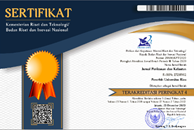Abundance and Chlorophyll-a Content of Spirulina sp in Given Different Light Intensity Media’s
(1) Department of Aquaculture, Faculty of Fisheries and Marine, Universitas Riau
(2) Department of Aquaculture, Faculty of Fisheries and Marine, Universitas Riau
(3) Department of Aquaculture, Faculty of Fisheries and Marine, Universitas Riau
(*) Corresponding Author
Abstract
Keywords
Full Text:
PDFReferences
Anggraeni., Novita, M., Nurlita, A. (2013). Pengaruh pemberian pakan alami dan pakan buatan terhadap pertumbuhan ikan betutu (Oxyeleotris Marmorata) pada skala laboratorium. Jurnal Sains dan Seni ITS, 2(2): 197–201.
Armanda, D.T. (2013). Pertumbuhan kultur mikroalga diatom Sceletonema costatum (Greville) Cleve isolat jepara pada medium F/2 dan Medium Conway. Program Studi Tadris Biologi Fakultas Ilmu Tarbiyah dan Keguruan IAIN Walisongo Semarang.
Astiani, F.I., Dewiyanti, D., Melisa, S. (2016). Effect of different culture media on growth rate and biomass of Spirulina sp. Jurnal Ilmiah Mahasiswa Kelautan dan Perikanan Unsyiah 1(November): 441–447.
Boroh, R., Litaay, M., Umar, M.R., Ambeng, A. (2019). Pertumbuhan Chlorella sp pada beberapa kombinasi media kultur. BIOMA: Jurnal Biologi Makassar, 4(2): 129–137.
Budiardi, N.B.P.U., Santosa, A. (2010). Pertumbuhan dan kandungan nutrisi Spirulina sp pada fotoperiode yang berbeda. Jurnal Akuakultur Indonesia, 9(2): 146–156.
Buwono, N., Nurhasan, R. (2018). Study of Spirulina sp population growth in the different culture scale. Jurnal Ilmiah Perikanan dan Kelautan, 10(1): 26–33.
Febriani, R., Hasibuan, S., Syafriadiman, S. (2020). Pengaruh intensitas cahaya berbeda terhadap kepadatan dan kandungan karotenoid Dunaliella salina. Jurnal Perikanan dan Kelautan, 25(1): 36-43.
Hadiyanto, H., Nur, M.A., Hartanto, G.D. (2012). Cultivation of Chlorella sp as biofuel sources in palm oil mill effluent (POME). International Journal of Renewable Energy Development, 1(2).
Herawati, V.E., Hutabarat, J. (2014). Pengaruh pertumbuhan, lemak dan profil asam amino essensial Skeletonema costatum dalam kultur massa menggunakan media kultur teknis yang berbeda. Jurnal Aquasains, 2(3): 221- 226.
Kalsum, U., Siti, F., Catur, W. (2011). Efektivitas pemberian air leri terhadap pertumbuhan dan hasil jamur tiram putih (Pleurotus ostreatus). Jurnal Agrovigor, 4(2): 86–92.
Kawaroe, M., Prartono, T., Sunuddin, A., Sari, D.W., Augustine, D. (2012). Laju pertumbuhan spesifik dan kandungan asam lemak pada mikroalga Spirulina platensis, Isochrysis sp dan Porphyridium cruentum. Jurnal Ilmu Kelautan, 17(3): 125-131.
Kurniawan, M., Izzati, M., Nurchayati Y. (2010). Kandungan klorofil, karotenoid, dan vitamin C pada beberapa spesies tumbuhan akuatik. Buletin Anatomi dan Fisiologi, 18(1).
Mackentum, K.M. (1969). The practice of water pollution biology. United States Department of Interior. Federal Water Pollution Control Administration, Division of Technical Support. 411
Meirinawati, H., Fitriya, N. (2018). Pengaruh konsentrasi nutrien terhadap kelimpahan fitoplankton di perairan Halmahera-Maluku. Oseanologi dan Limnologi di Indonesia, 3(3): 183–195.
Muliani, M., Ayuzar, E., Amri, M. (2018). Pengaruh pemberian pupuk kascing (bekas cacing) yang difermentasi dengan dosis yang berbeda dalam kultur Spirulina sp. Acta Aquatica: Aquatic Sciences Journal, 5(1): 30–35.
Nababan, T.M.R., Hasibuan, S., Syafriadiman, S. (2021). Abundance of phytoplankton in the peat soil media with given a mixture of biofertilizers. Jurnal Perikanan dan Kelautan, 26(3): 154-160.
Nielsen, N. (2017). Development of fungal cell factories for the production of secondary metabolites: Linking genomics and metabolism. Synthetic and Systems Biotechnology, 2: 5–12.
Nur, S.A.U., Julyantora, P.G.D.S., Dewia, A.P.W.K. (2020). Pengaruh penambahan air cucian beras terhadap laju pertumbuhan Spirulina sp. Current Trends in Aquatic Science III, 22(1): 15–22.
Octhreeani, A. M., Supriharyono, & Soedarsono, P. (2014). Pengaruh perbedaan jenis pupuk terhadap pertumbuhan Nannochloropsis sp dilihat dari kepadatan sel dan klorofil-α pada skala semi masal. Journal Diponegoro of Maquares, 3(2): 102–108.
Parslow, J., Hunter, J., Davidson, A. (2008). Estuarine eutrophication models. Final report project E6 national river health program. Water Services Association of Melbourne Australia. CSIRO Marine Research. Hobart, Tasmania.
Prasanna, R., Sood, A., Jaiswal, P., Nayak, S., Gupta, V., Chaudhary, V., Natarajan, C. (2010). Rediscovering cyanobacteria as valuable sources of bioactive compounds. Applied Biochemistry and Microbiology, 46: 119-134.
Putri, D.L., Setyati, R.H. (2019). Optimasi pH pertumbuhan mikroalga Spirulina sp menggunakan air laut yang diperkaya media Walne. Universitas Sanata Dharma. Yogyakarta. p96.
Rusyani, E. (2001). Pengaruh dosis zeolit yang berbeda terhadap pertumbuhan Isochrysis galbana klon Tahiti skala laboratorium dalam media komersial. Program Studi Budidaya Perairan. Fakultas Perikanan dan Ilmu Kelautan. Institut Pertanian Bogor. Bogor.
Simatupang, D.E., Syafriadiman, S., Hasibuan, S. (2023). The effect of water hyacinth biomass (Eichornia crassipes) on the concentration of chlorophyll-a on local catfish (Clarias batrachus) rearing. Jurnal Perikanan dan Kelautan, 28(1): 7-17.
Sukmawan, M.A., Semedi, A.N., Arnata, I.W. (2014). Optimization salinity and initial pH on the biomass production of Nannochloropsis sp K-4. Jurnal Rekayasa dan Manajemen Agroindustri, 2(1): 19–28.
Tungka, A.W., Haeruddin, H., Ain. C. (2016). Konsentrasi nitrat dan ortofosfat di Muara Sungai Banjir Kanal Barat dan kaitannya dengan kelimpahan fitoplankton. Journal of Fisheries Science and Technology, 12(1): 40-46
Article Metrics
Abstract view : 45 timesPDF - 20 times
DOI: http://dx.doi.org/10.31258/jpk.29.2.152-161
Copyright (c) 2024 Sri Nadila Sari, Saberina Hasibuan, Syafriadiman

This work is licensed under a Creative Commons Attribution-NonCommercial-NoDerivatives 4.0 International License.
Gedung Marine Center Lt 2. Fakultas Perikanan dan Kelautan Universitas Riau



